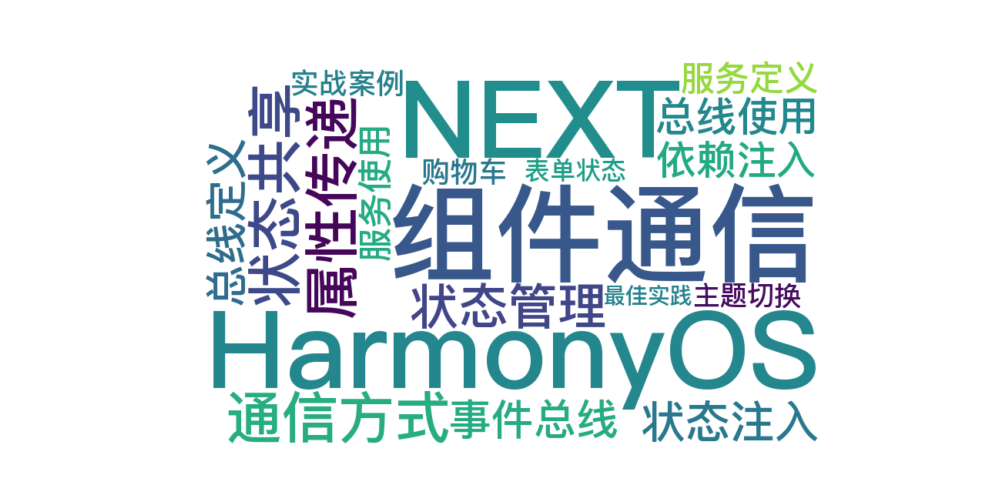86.HarmonyOS NEXT 组件通信与状态共享:构建高效的组件协作机制
2025-03-16 23:29:07
328次阅读
0个评论
温馨提示:本篇博客的详细代码已发布到 git : https://gitcode.com/nutpi/HarmonyosNext 可以下载运行哦!

HarmonyOS NEXT 组件通信与状态共享:构建高效的组件协作机制
1. 组件通信基础
1.1 通信方式概述
| 通信方式 | 使用场景 | 优点 | 缺点 |
|---|---|---|---|
| 属性传递 | 父子组件 | 简单直接 | 层级限制 |
| 事件机制 | 子到父通信 | 解耦合 | 单向流动 |
| 状态管理 | 全局状态 | 统一管理 | 复杂度高 |
| 依赖注入 | 跨组件共享 | 高度解耦 | 配置繁琐 |
1.2 基本属性传递
// 子组件
@Component
struct ChildComponent {
@Prop title: string; // 接收父组件传递的属性
@State private count: number = 0;
build() {
Column() {
Text(this.title)
Button(`Count: ${this.count}`)
.onClick(() => {
this.count++;
})
}
}
}
// 父组件
@Component
struct ParentComponent {
@State private pageTitle: string = 'Hello';
build() {
Column() {
ChildComponent({
title: this.pageTitle
})
}
}
}
2. 状态共享机制
2.1 状态管理器
// 全局状态定义
class AppState {
@Observed
class UserState {
isLoggedIn: boolean = false;
username: string = '';
preferences: Map<string, any> = new Map();
}
@Observed
class ThemeState {
isDark: boolean = false;
primaryColor: string = '#000000';
fontSize: number = 14;
}
user: UserState = new UserState();
theme: ThemeState = new ThemeState();
}
// 状态管理器
class StateManager {
private static instance: StateManager;
private state: AppState = new AppState();
static getInstance(): StateManager {
if (!this.instance) {
this.instance = new StateManager();
}
return this.instance;
}
getState(): AppState {
return this.state;
}
// 更新用户状态
updateUserState(updates: Partial<AppState['user']>) {
Object.assign(this.state.user, updates);
}
// 更新主题状态
updateThemeState(updates: Partial<AppState['theme']>) {
Object.assign(this.state.theme, updates);
}
}
2.2 状态注入与使用
@Component
struct ThemeAwareComponent {
@ObjectLink themeState: AppState['theme'];
build() {
Column() {
Text('Current Theme')
.fontSize(this.themeState.fontSize)
.fontColor(this.themeState.primaryColor)
Toggle({ type: ToggleType.Switch, isOn: this.themeState.isDark })
.onChange((isOn: boolean) => {
this.themeState.isDark = isOn;
})
}
}
}
3. 事件总线实现
3.1 事件总线定义
type EventCallback = (...args: any[]) => void;
class EventBus {
private static instance: EventBus;
private events: Map<string, Set<EventCallback>> = new Map();
static getInstance(): EventBus {
if (!this.instance) {
this.instance = new EventBus();
}
return this.instance;
}
// 订阅事件
on(event: string, callback: EventCallback): void {
if (!this.events.has(event)) {
this.events.set(event, new Set());
}
this.events.get(event).add(callback);
}
// 取消订阅
off(event: string, callback: EventCallback): void {
if (this.events.has(event)) {
this.events.get(event).delete(callback);
}
}
// 触发事件
emit(event: string, ...args: any[]): void {
if (this.events.has(event)) {
this.events.get(event).forEach(callback => {
callback(...args);
});
}
}
}
3.2 事件总线使用
@Component
struct EventComponent {
private eventBus = EventBus.getInstance();
@State private message: string = '';
aboutToAppear() {
// 订阅事件
this.eventBus.on('updateMessage', (msg: string) => {
this.message = msg;
});
}
aboutToDisappear() {
// 取消订阅
this.eventBus.off('updateMessage', this.handleMessage);
}
build() {
Column() {
Text(this.message)
Button('Send Message')
.onClick(() => {
this.eventBus.emit('updateMessage', 'Hello from EventBus!');
})
}
}
}
4. 依赖注入
4.1 服务定义
interface UserService {
getCurrentUser(): Promise<User>;
updateProfile(data: Partial<User>): Promise<void>;
}
@Injectable
class UserServiceImpl implements UserService {
async getCurrentUser(): Promise<User> {
// 实现获取用户信息的逻辑
return null;
}
async updateProfile(data: Partial<User>): Promise<void> {
// 实现更新用户信息的逻辑
}
}
// 依赖注入容器
class Container {
private static instance: Container;
private services: Map<string, any> = new Map();
static getInstance(): Container {
if (!this.instance) {
this.instance = new Container();
}
return this.instance;
}
// 注册服务
register<T>(token: string, implementation: T): void {
this.services.set(token, implementation);
}
// 获取服务
resolve<T>(token: string): T {
if (!this.services.has(token)) {
throw new Error(`Service ${token} not found`);
}
return this.services.get(token);
}
}
4.2 服务使用
@Component
struct UserProfileComponent {
@Inject('UserService') userService: UserService;
@State private user: User = null;
async aboutToAppear() {
try {
this.user = await this.userService.getCurrentUser();
} catch (error) {
console.error('Failed to load user:', error);
}
}
build() {
Column() {
if (this.user) {
Text(this.user.name)
Button('Update Profile')
.onClick(async () => {
await this.userService.updateProfile({
name: 'New Name'
});
})
}
}
}
}
5. 实战案例
5.1 购物车状态管理
// 购物车状态
@Observed
class CartState {
items: Map<string, CartItem> = new Map();
total: number = 0;
addItem(item: Product, quantity: number = 1) {
const cartItem = this.items.get(item.id) || {
product: item,
quantity: 0
};
cartItem.quantity += quantity;
this.items.set(item.id, cartItem);
this.calculateTotal();
}
removeItem(itemId: string) {
this.items.delete(itemId);
this.calculateTotal();
}
private calculateTotal() {
this.total = Array.from(this.items.values())
.reduce((sum, item) =>
sum + item.product.price * item.quantity, 0);
}
}
// 购物车组件
@Component
struct CartComponent {
@ObjectLink cartState: CartState;
build() {
Column() {
// 购物车列表
List() {
ForEach(Array.from(this.cartState.items.values()),
(item: CartItem) => {
ListItem() {
CartItemComponent({ item })
}
})
}
// 总计
Row() {
Text(`Total: $${this.cartState.total.toFixed(2)}`)
Button('Checkout')
.onClick(() => {
// 处理结算逻辑
})
}
}
}
}
5.2 主题切换实现
// 主题定义
interface Theme {
primaryColor: string;
backgroundColor: string;
textColor: string;
fontSize: {
small: number;
medium: number;
large: number;
};
}
// 主题服务
@Injectable
class ThemeService {
private currentTheme: Theme;
private eventBus = EventBus.getInstance();
setTheme(theme: Theme) {
this.currentTheme = theme;
this.eventBus.emit('themeChanged', theme);
}
getTheme(): Theme {
return this.currentTheme;
}
}
// 主题感知组件
@Component
struct ThemeAwareButton {
@Inject('ThemeService') themeService: ThemeService;
private text: string;
@State private theme: Theme;
aboutToAppear() {
this.theme = this.themeService.getTheme();
EventBus.getInstance().on('themeChanged',
(newTheme: Theme) => {
this.theme = newTheme;
});
}
build() {
Button(this.text)
.backgroundColor(this.theme.primaryColor)
.fontColor(this.theme.textColor)
.fontSize(this.theme.fontSize.medium)
}
}
5.3 表单状态管理
// 表单状态
@Observed
class FormState {
values: Map<string, any> = new Map();
errors: Map<string, string> = new Map();
isDirty: boolean = false;
setValue(field: string, value: any) {
this.values.set(field, value);
this.isDirty = true;
this.validate(field);
}
setError(field: string, error: string) {
this.errors.set(field, error);
}
validate(field: string) {
// 实现字段验证逻辑
}
isValid(): boolean {
return this.errors.size === 0;
}
}
// 表单组件
@Component
struct FormComponent {
@ObjectLink formState: FormState;
build() {
Column() {
TextInput({
placeholder: 'Username'
})
.onChange((value: string) => {
this.formState.setValue('username', value);
})
if (this.formState.errors.has('username')) {
Text(this.formState.errors.get('username'))
.fontColor(Color.Red)
}
Button('Submit')
.enabled(this.formState.isValid())
.onClick(() => {
// 处理表单提交
})
}
}
}
5.4 最佳实践建议
-
状态管理
- 合理划分状态范围
- 避免状态重复
- 实现状态同步机制
-
组件通信
- 选择合适的通信方式
- 保持单向数据流
- 避免过度耦合
-
依赖注入
- 合理使用服务抽象
- 实现依赖的解耦
- 便于单元测试
-
性能优化
- 避免不必要的状态更新
- 合理使用事件解绑
- 优化组件重渲染
通过合理使用组件通信和状态共享机制,可以构建出结构清晰、易于维护的应用。在实际开发中,要根据具体需求选择合适的通信方式,并注意性能优化和代码质量。
00
- 0回答
- 5粉丝
- 0关注
相关话题
- HarmonyOS NEXT 头像制作项目系列教程之 ---HarmonyOS数据共享与状态管理教程
- 《探索 HarmonyOS NEXT (5.0):开启构建模块化项目架构奇幻之旅 —— 动态路由 ZRouter:引领高效模块通信的智慧中枢》
- 175.HarmonyOS NEXT系列教程之列表交换组件状态管理机制
- 第五八课:HarmonyOS Next的团队协作:工具使用与最佳实践
- 24.[HarmonyOS NEXT Column案例五(上)] 构建高效复合布局:垂直列表与水平操作栏的完美结合
- 《HarmonyOSNext超全开发指南:UIAbility组件与跨端协作完全解析》
- HarmonyOS NEXT开发实战:打造高效上拉刷新与下拉加载组件(一)空页面的设计与实现
- 74.HarmonyOS NEXT ImageItemView组件深度剖析:组件基础结构与核心状态管理(一)
- 203.HarmonyOS NEXT系列教程之 TabsConcaveCircle组件基础结构与状态管理
- 【HarmonyOS 5】鸿蒙组件&模板服务详解 - 助力高效开发的利器
- 209.HarmonyOS NEXT系列教程之 TabsConcaveCircle组件状态管理与生命周期
- 鸿蒙开发中父子组件如何进行数据通信(状态管理v1版)?
- 116.HarmonyOS NEXT 跑马灯组件详解(四):动画实现机制
- 112.HarmonyOS NEXT 跑马灯组件数据源详解:数据管理与监听机制
- 43.[HarmonyOS NEXT Row案例十一] 构建智能分页控件:Row组件实现页码与翻页按钮的完美结合
